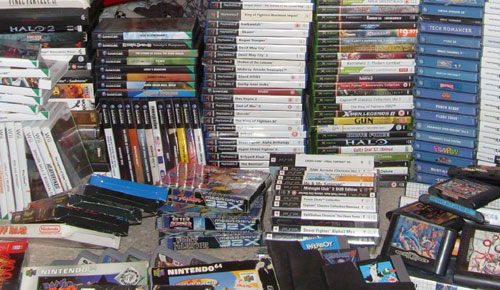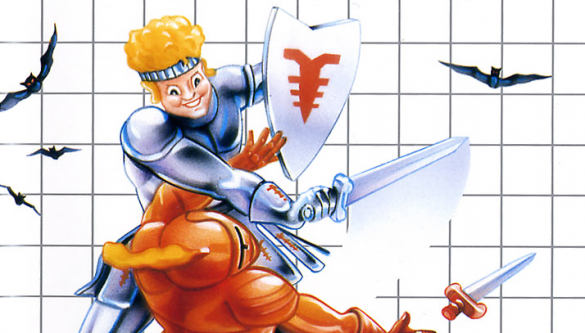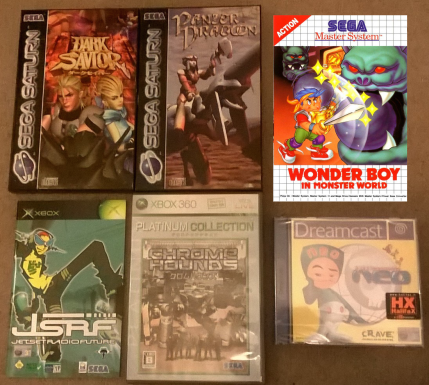One man, Harry Nezumi — some say brave, others foolish — stands against his backlog. With but five months between now and a move some 9,000 kms from home, does he have what it takes to complete all the outstanding games in his collection? Follow his quest, his Sisyphean toil, here on Sega Addicts as he tackles one hundred and seven games over twenty weeks. The journey will not be easy, the day grows dark and the hour late. Yet there is hope. Did our intrepid hero make up for lost time? What about Jet Set Radio Future? Find out below!
Completed: Wonderboy in Monster Land (XBLA); Space Channel 5 (DC); D (Sat); SpikeOut Battlestreet (oXB); Anarchy Reigns (360).
Postponed: Jet Set Radio Future (oXB).
Retired: N/A.
I almost feel like I’m picking on Jet Set Radio Future, kicking its can down the road for the third week in a row. Time pressure, it’s always time, got the better of me and, as the game that I have the most experience with (and no small amount of dislike) it was JSRF that had to give. It was a poor week for quality all round with only Anarchy Reigns gaining relatively unqualified praise. Next week will mark attempt number four at playing JSRF, hopefully some of the other titles will provide more entertainment than was on offer this time. I’m closing in on the end game of this little project, fingers crossed for more quality and productivity.
Game of the Week: Anarchy Reigns (360)
Nightmare of the Week: D (Sat)
Wonderboy in Monster Land (XBLA) — This title and Fantasy Zone are the two reasons I fell in love with Sega. Looking at the game with more than two decades of distance reveals its many strengths as one of the earliest forms of ‘action’ RPGs, but some of its glaring weaknesses. Sadly, these negatives are few in number but structural to the game. That this was designed to munch quarters, 20 pence pieces and ¥100 coins shows in the trial-and-error aspects. Most egregious is the use of equipment upgrades. Despite offering a plethora of choice with armour, shields and boots, there is a clear preferred course to take. This will reveal itself once an impasse is reached and the only way to progress is to start over. It further betrays its arcade heritage with the timer, ticking down and slowly whittling away Shion’s life. It combines to create a title that, whilst playing very well for the upon release, does not actually feel fair. Wonderboy in Monster Land is a snapshot back in time, when it was released it felt like a highly compelling, living, breathing world. Time was fickle and has left behind a title for which it is very difficult for the modern player to connect. As a game it is important, but sadly no longer relevant. 2/5
Space Channel 5 (DC) — An adventure that mixes Top of the Pops when it was the ‘Hit Parade’ with James Bond movies when they were camper than a row of pink tents, Space Channel 5 is unlike anything else out there for both better and worse. Whereas most rhythm games choose to have the player focussed on one part of the screen, where the button prompts appear, SC5 relays that information by sound only. There are visual hints, with the layout of enemies around the whole screen giving some clue as to what is needed, but it is markedly more challenging than a normal rhythm-action title. Indeed, this requirement to parse the whole screen is similar to the Project Diva titles, albeit with less information relayed. Ulala’s first adventure is hugely stylish, owing a debt to West End musicals, and really quite demanding. It is undoubtedly a game worth experiencing for its unique take on the genre, but it is this one-of-a-kind nature that will make it not universally loved. Ulala always felt like she was destined for greater things, the premature death of the Dreamcast put an end to that, don’t let it have been in vain. 3/5
D (Sat) — As a huge fan of Kenji Eno’s work it was surprising that I had ignored D, very much his breakthrough title in the West, for so long. Whilst most often referred to as an interactive movie, the reality is that this is closer in gameplay to a point ’n’ click adventure game. Unfortunately, Eno’s commitment to marrying gaming and cinema has resulted in large amounts of FMV. With only 2 CDs for his vision, actual gameplay is sorely limited. The design of D attempts to compensate, the two hour time limit (no pausing, no saving) means that, without a guide, the game will need to be played multiple times in order to solve the puzzles. At launch D would have wowed audiences with its production values, creepy atmosphere and graphical finesse. All these features have aged poorly and they are no longer enough to carry the game. Fundamentally there is not enough ‘game’ here as it plays like a short, slow Lucasfilm title with collecting items and using them in the pre-selected places. It is interesting as a snapshot into the past of the medium, but sadly, D in this instance stands for dated. 2/5
SpikeOut Battlestreet (oXB) — Back when the Saturn was really starting to sag, many began pleading for Sega to bring two of its arcade greats to the format. SCUD Race and SpikeOut featured prominently in the letters pages of publications as the faithful demanded their conversion. With 20/20 hindsight it’s clear that this would not have saved the Saturn, but it did pique my interest in games apparently so good that people thought they could rescue the system. We had to wait another full generation, and for non-Sega hardware, to get a SpikeOut on home console though, and it is difficult to say if it was worth the wait. With some of Sega’s heavy hitters like Dimps and Nagoshi involved, SpikeOut Battlestreet was always going to be more than the average scrolling brawler. However, the pure arcade heritage of the title makes it relatively inaccessible. Where once the player could simply funnel quarters into the machine, the conversion team has seen fit to replace this mechanic not with lives (plural), but a life (singular). Of course, there are no mid-level checkpoints. This choice gets in the way of what would otherwise be an excellent game. The action is fluid, the presentation fun and the story is suitably ridiculous. However, it is the fundamental inaccessibility of a title poorly optimized for the home market that leaves the most prominent impression. 3/5
Anarchy Reigns (360) — It’s Platinum Games, everyone knows what to expect. There’s an emphasis on mechanical depth, a purity to gameplay usually only seen with shoot ‘em-ups (I still refuse to use the term ‘shmup’) and, of course, a story so ridiculous it serves to only to loosely connect the action scenes. Anarchy Reigns has all of these factors in spades and the relative simplicity of the experience belies a high skill ceiling. All told, this is not the tour d’force of Bayonetta, it lacks the customization options for example, but it is undoubtedly one of the better arcade action games of the generation. Structurally, the player chooses a light or dark side character, opening up both story and extra levels by racking up points from combat. It is combat with a side order of combat, fixings of combat and combat for dessert. The true depth comes from the variety of enemies faced, having to use the moveset and skills to cope with an array of enemies liberally thrown at the protagonist. The boss battles, once more a hallmark of Platinum Games, are engaging as always and round out a package of genuine quality. The focussed nature of Anarchy Reigns means it will not suit everyone’s taste, but for those who love arcade action titles the only better games in the genre are by Platinum themselves. 4/5





Waiting for SEGA Port JSRF on Steam.